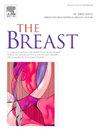Hyaluronic acid 0.2 % cream for preventing radiation dermatitis in breast cancer patients treated with postoperative radiotherapy: A randomized, double-blind, placebo-controlled study
IF 7.9
2区 医学
Q1 OBSTETRICS & GYNECOLOGY
引用次数: 0
Abstract
Introduction
This randomized trial evaluated the efficacy and safety of the prophylactic use of a hyaluronic acid (HA) 0.2 %-containing cream to reduce acute radiodermatitis in breast cancer patients undergoing adjuvant radiotherapy (RT).
Methods
Candidates for conventionally-fractionated or hypofractionated adjuvant RT for unilateral stage I-III breast cancer were randomized 1:1 to the HA cream or neutral comparator applied twice daily from 14 days before starting until 14 days after completing local RT. The primary endpoint was the development of acute skin dermatitis of grade ≥2 according to RTOG scale at the end of RT.
Results
The study closed early after 86 of the planned 120 patients were enrolled because of an unexpectedly low frequency of acute skin toxicity. Cumulative acute grade ≥2 radiodermatitis was lower with the HA cream (21.1 %) than the comparator group (35.3 %) but did not reach statistical significance in the primary endpoint (p = 0.3). At the end of RT, acute dermatitis grade ≥1 occurred in 92 % of patients undergoing conventionally-fractionated RT and 50 % in the hypofractionation subgroup. Physician-based RTOG grading scale and quantitative assessment with skin reflectance spectrophotometry (SRS) measures were comparable in detecting skin toxicity. However, an increase in SRS values was detectable a week before the first signs of radiodermatitis were depicted using RTOG scores.
Conclusion
Compared to physician-based grading, SRS enabled earlier detection of skin toxicity and may be used as a valid and effective tool for assessing radiodermatitis. Prophylactic topical HA may help mitigate this toxicity; however adequately powered prospective trials are needed.
0.2%透明质酸乳膏预防乳腺癌术后放疗患者放射性皮炎:一项随机、双盲、安慰剂对照研究
本随机试验评估了预防性使用含0.2%透明质酸(HA)乳膏减少接受辅助放疗(RT)的乳腺癌患者急性放射性皮炎的有效性和安全性。MethodsCandidates conventionally-fractionated或hypofractionated佐剂RT单边阶段》乳腺癌随机1:1 HA奶油或中立的比较器应用每天两次从开始前14天到14天之后完成当地RT发展的主要终点是急性皮肤皮炎等级≥2根据RTOG规模RT.ResultsThe研究结束时关闭后,86年初计划中的120名患者因为意外低频率的急性皮肤毒性。HA乳膏组的累积急性≥2级放射性皮炎发生率(21.1%)低于对照组(35.3%),但在主要终点无统计学意义(p = 0.3)。在放射治疗结束时,92%接受常规分割放射治疗的患者发生急性皮炎等级≥1级,50%接受低分割放射治疗的患者发生急性皮炎等级≥1级。基于医生的RTOG分级量表和采用皮肤反射分光光度法(SRS)的定量评估在检测皮肤毒性方面具有可比性。然而,在使用RTOG评分描述放射性皮炎的第一个迹象之前一周,可以检测到SRS值的增加。结论与基于医生的分级相比,SRS能够更早地发现皮肤毒性,并可作为评估放射性皮炎的有效工具。预防性局部透明质酸可能有助于减轻这种毒性;然而,需要足够有力的前瞻性试验。
本文章由计算机程序翻译,如有差异,请以英文原文为准。
求助全文
约1分钟内获得全文
求助全文
来源期刊

Breast
医学-妇产科学
CiteScore
8.70
自引率
2.60%
发文量
165
审稿时长
59 days
期刊介绍:
The Breast is an international, multidisciplinary journal for researchers and clinicians, which focuses on translational and clinical research for the advancement of breast cancer prevention, diagnosis and treatment of all stages.
 求助内容:
求助内容: 应助结果提醒方式:
应助结果提醒方式:


